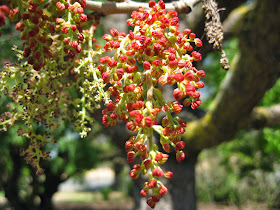The Chinese Pistache is a medium to fast growing deciduous tree. Around here it grows to about 25-30' but can get much larger in warmer climates (I saw some in Chico that were 50 feet or so). It has a rounded canopy with branching going every which way, especially when young (like the kid with size 12 shoes). It does not develop a central leader but has three or four main scaffold branches arising from the main stem. This is the same planting in late fall.
If you plant the female tree you will likely end up with something like this in the early winter, this was Dec 23.
The leaves are alternate, odd-pinnately compound, with 10-16 leaflets, broadly lanceolate with acuminate tips, and a beautiful dark green color. Fall color is a great orange-red color, sometimes a bit yellow.
New foliage in the spring can be reddish.
Stems are smooth when young, slightly noticeable lenticles, with a sharp pointed terminal bud. You can see the alternation of the leaf arrangement here as well as the red petioles.
Trees are dioecious, male and female flowers on different trees. A very common cultivar is 'Keith Davey', a male. Flowering before leaving out, on old wood so they dont appear at the ends of the branches. These are the male flowers of 'Keith Davey'.
Fruit is a small, 1/8-1/4" single seeded drupe, bright to dull red or pink colored, turning blue or black when full mature. Falling in large quantities making a bit of a mess on sidewalks or patios.
Misidentification? Leaves are somewhat like a Cassia, but not as large or leathery dark green (nor is the tree evergreen). There a lots of compound leaved plants around. Look for the pointed buds.
Location: Everywhere. This a a very common tree that works well in most areas. Tolerant of low water, compacted sites.










